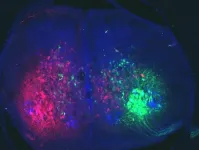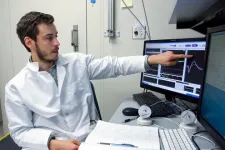New discovery shows human cells can write RNA sequences into DNA
In a discovery that challenges long-held dogma in biology, researchers show that mammalian cells can convert RNA sequences back into DNA, a feat more common in viruses than eukaryotic cells
2021-06-11
(Press-News.org) PHILADELPHIA - Cells contain machinery that duplicates DNA into a new set that goes into a newly formed cell. That same class of machines, called polymerases, also build RNA messages, which are like notes copied from the central DNA repository of recipes, so they can be read more efficiently into proteins. But polymerases were thought to only work in one direction DNA into DNA or RNA. This prevents RNA messages from being rewritten back into the master recipe book of genomic DNA. Now, Thomas Jefferson University researchers provide the first evidence that RNA segments can be written back into DNA, which potentially challenges the central dogma in biology and could have wide implications affecting many fields of biology.
"This work opens the door to many other studies that will help us understand the significance of having a mechanism for converting RNA messages into DNA in our own cells," says Richard Pomerantz, PhD, associate professor of biochemistry and molecular biology at Thomas Jefferson University. "The reality that a human polymerase can do this with high efficiency, raises many questions." For example, this finding suggests that RNA messages can be used as templates for repairing or re-writing genomic DNA.
The work was published June 11th in the journal Science Advances.
Together with first author Gurushankar Chandramouly and other collaborators, Dr. Pomerantz's team started by investigating one very unusual polymerase, called polymerase theta. Of the 14 DNA polymerases in mammalian cells, only three do the bulk of the work of duplicating the entire genome to prepare for cell division. The remaining 11 are mostly involved in detecting and making repairs when there's a break or error in the DNA strands. Polymerase theta repairs DNA, but is very error-prone and makes many errors or mutations. The researchers therefore noticed that some of polymerase theta's "bad" qualities were ones it shared with another cellular machine, albeit one more common in viruses -- the reverse transcriptase. Like Pol theta, HIV reverse transcriptase acts as a DNA polymerase, but can also bind RNA and read RNA back into a DNA strand.
In a series of elegant experiments, the researchers tested polymerase theta against the reverse transcriptase from HIV, which is one of the best studied of its kind. They showed that polymerase theta was capable of converting RNA messages into DNA, which it did as well as HIV reverse transcriptase, and that it actually did a better job than when duplicating DNA to DNA. Polymerase theta was more efficient and introduced fewer errors when using an RNA template to write new DNA messages, than when duplicating DNA into DNA, suggesting that this function could be its primary purpose in the cell.
The group collaborated with Dr. Xiaojiang S. Chen's lab at USC and used x-ray crystallography to define the structure and found that this molecule was able to change shape in order to accommodate the more bulky RNA molecule - a feat unique among polymerases.
"Our research suggests that polymerase theta's main function is to act as a reverse transcriptase," says Dr. Pomerantz. "In healthy cells, the purpose of this molecule may be toward RNA-mediated DNA repair. In unhealthy cells, such as cancer cells, polymerase theta is highly expressed and promotes cancer cell growth and drug resistance. It will be exciting to further understand how polymerase theta's activity on RNA contributes to DNA repair and cancer-cell proliferation."
INFORMATION:
This research was supported by NIH grants 1R01GM130889-01 and 1R01GM137124-01, and R01CA197506 and R01CA240392. This research was also supported in part by a Tower Cancer Research Foundation grant. The authors report no conflicts of interest.
Article reference: Gurushankar Chandramouly, Jiemin Zhao, Shane McDevitt, Timur Rusanov, Trung Hoang, Nikita Borisonnik, Taylor Treddinick, Felicia Wednesday Lopezcolorado, Tatiana Kent, Labiba A. Siddique, Joseph Mallon, Jacklyn Huhn, Zainab Shoda, Ekaterina Kashkina, Alessandra Brambati, Jeremy M. Stark, Xiaojiang S. Chen, and Richard T. Pomerantz, "Pol theta reverse transcribes RNA and promotes RNA-templated DNA repair," Science Advances, DOI: 10.1126/sciadv.abf1771, 2021.
Media Contact: Edyta Zielinska, 267-234-3553, edyta.zielinska@jefferson.edu
ELSE PRESS RELEASES FROM THIS DATE:
2021-06-11
BOSTON - Vitamin D deficiency strongly exaggerates the craving for and effects of opioids, potentially increasing the risk for dependence and addiction, according to a new study led by researchers at Massachusetts General Hospital (MGH). These findings, published in Science Advances, suggest that addressing the common problem of vitamin D deficiency with inexpensive supplements could play a part in combating the ongoing scourge of opioid addiction.
Earlier work by David E. Fisher, MD, PhD, director of the Mass General Cancer Center's Melanoma Program and director of MGH's Cutaneous Biology Research Center (CBRC), laid the foundation for the current study. In 2007, Fisher and his team found something unexpected: Exposure to ultraviolet (UV) rays ...
2021-06-11
For centuries, scientists, aeronautic designers and adventure-seekers have sought to replicate the qualities that allow birds to fly, namely wing-structure and balance. However, without an external mechanism such as a hot air balloon or airplane, humans have remained earth-bound, unable to use their own bodies to propel themselves into the stratosphere.
While researchers have long-focused on structural factors, like wings, that define the category of bird, a recent study published Science Advances by Professor Avihu Klar at the Hebrew University of Jerusalem's Faculty of Medicine and Prof. Claudio Mello from Oregon Health and Science University found that there are specific molecular characteristics that distinguish birds from animals, and these differences allow birds to flap their ...
2021-06-11
The enormous potential of Big Data has already been demonstrated in areas such as financial services and telecommunications. An international team of researchers led by the IPK Leibniz Institute has now tapped the potential of big data for the first time on a large scale for plant research. To this end, data from three projects were used to increase the predictive accuracy for yield in hybrid varieties of wheat.
"We were able to draw on the largest dataset published to date, which contains information from almost a decade of wheat research and development," says Prof. Dr. Jochen Reif, Head of the Breeding Research Department at IPK. ...
2021-06-11
What The Study Did: Editorial team composition by gender, race, ethnicity and sexual orientation was assessed at 25 leading medical and scientific journals in this survey study.
Authors: James W. Salazar, M.D., M.A.S., of the University of California San Francisco, is the corresponding author.
To access the embargoed study: Visit our For The Media website at this link https://media.jamanetwork.com/
(doi:10.1001/jamainternmed.2021.2363)
Editor's Note: The article includes conflicts of interest disclosures. Please see the article for additional information, including other authors, author contributions and affiliations, ...
2021-06-11
What The Study Did: International medical graduates often practice as physicians in locations and specialties less preferred by U.S. medical graduates. This study reports on physician mortality from COVID-19, and on the mortality of international medical graduates in particular.
Authors: Abraham Verghese, M.D., of Stanford University in California, is the corresponding author.
To access the embargoed study: Visit our For The Media website at this link https://media.jamanetwork.com/
(doi:10.1001/jamanetworkopen.2021.13418)
Editor's Note: The article includes conflict of interest and funding/support disclosures. Please see the article for additional information, ...
2021-06-11
What The Study Did: Researchers describe international hospitalization trends and key epidemiological and clinical features of children and youth with COVID-19.
Authors: Paul Avillach, M.D., Ph.D., of Harvard Medical School in Boston, and Florence Bourgeois, M.D., M.P.H., of Boston Children's Hospital, are the corresponding authors.
To access the embargoed study: Visit our For The Media website at this link https://media.jamanetwork.com/
(doi:10.1001/jamanetworkopen.2021.12596)
Editor's Note: The article includes conflict of interest and funding/support disclosures. Please see the article for additional information, including ...
2021-06-11
The term "doomscrolling" describes the act of endlessly scrolling through bad news on social media and reading every worrisome tidbit that pops up, a habit that unfortunately seems to have become common during the COVID-19 pandemic.
The biology of our brains may play a role in that. Researchers at Washington University School of Medicine in St. Louis have identified specific areas and cells in the brain that become active when an individual is faced with the choice to learn or hide from information about an unwanted aversive event the individual ...
2021-06-11
What The Study Did: This study of patients hospitalized with COVID-19 examines the association of anticoagulation treatment with mortality rates.
Authors: Valerie M. Vaughn, M.D., M.Sc., of the University of Utah in Salt Lake City, is the corresponding author.
To access the embargoed study: Visit our For The Media website at this link https://media.jamanetwork.com/
(doi:10.1001/jamanetworkopen.2021.11788)
Editor's Note: The article includes conflict of interest and funding/support disclosures. Please see the article for additional information, including other authors, author contributions and affiliations, conflict of interest and financial disclosures, and funding and support.
INFORMATION:
Media advisory: The full ...
2021-06-11
What The Study Did: Researchers compared the association between symptoms and SARS-CoV-2 RNA levels in children and adults.
Authors: Erin Chung, M.D., of the University of Washington School of Medicine in Seattle, is the corresponding author.
To access the embargoed study: Visit our For The Media website at this link https://media.jamanetwork.com/
(doi:10.1001/jamapediatrics.2021.2025)
Editor's Note: The article includes conflict of interest and funding/support disclosures. Please see the article for additional information, including other authors, ...
2021-06-11
So-called "good fatty acids" are essential for human health and much sought after by those who try to eat healthily. Among the Omega-3 fatty acids, DHA or docosahexaenoic acid is crucial to brain function, vision and the regulation of inflammatory phenomena.
In addition to these virtues, DHA is also associated with a reduction in the incidence of cancer. How it works is the subject of a major discovery by a multidisciplinary team of University of Louvain (UCLouvain) researchers, who have just elucidated the biochemical mechanism that allows DHA and other related fatty acids to slow the development of tumours. This is a major advance that has recently been published ...
LAST 30 PRESS RELEASES:
[Press-News.org] New discovery shows human cells can write RNA sequences into DNA
In a discovery that challenges long-held dogma in biology, researchers show that mammalian cells can convert RNA sequences back into DNA, a feat more common in viruses than eukaryotic cells


